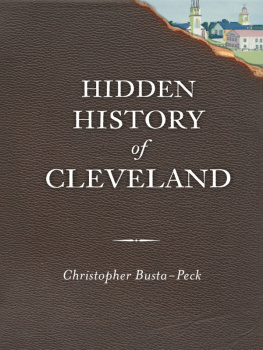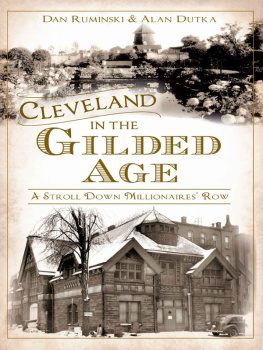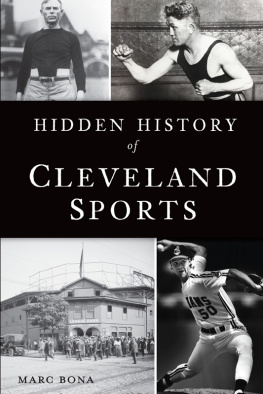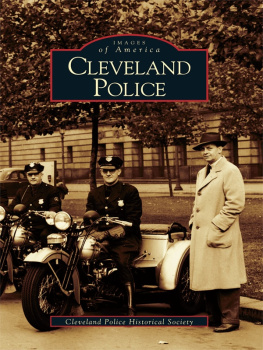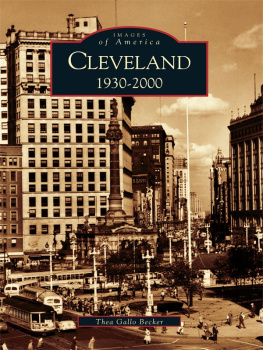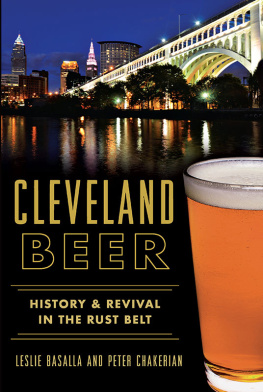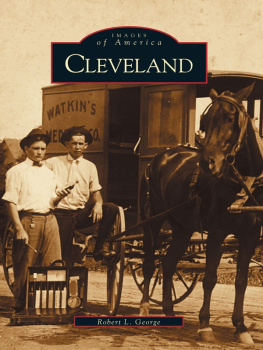
Published by The History Press
Charleston, SC 29403
www.historypress.net
Copyright 2011 by Christopher Busta-Peck
All rights reserved
First published 2011
Second printing 2012
Third printing 2013
e-book edition 2013
Manufactured in the United States
ISBN 978.1.62584.179.7
Busta-Peck, Christopher.
Hidden history of Cleveland / Christopher Busta-Peck.
p. cm.
Includes bibliographical references.
print edition ISBN 978-1-60949-439-1
1. Cleveland (Ohio)--History. 2. Cleveland (Ohio)--Social conditions. I. Title.
F499.C657B87 2011
977.132--dc23
2011039787
Notice: The information in this book is true and complete to the best of our knowledge. It is offered without guarantee on the part of the author or The History Press. The author and The History Press disclaim all liability in connection with the use of this book.
All rights reserved. No part of this book may be reproduced or transmitted in any form whatsoever without prior written permission from the publisher except in the case of brief quotations embodied in critical articles and reviews.
CONTENTS
ACKNOWLEDGEMENTS
When I began writing this section, I wanted to thank everyone who helped make this book what it isthere are so many people who ought to be named. I quickly realized that there was no way I could do this in a satisfactory manner; even if I went back through all of my notes, Id miss half the people who deserved to be mentioned, and that didnt seem fair. Even then, this section of names would have filled at least three pages.
Instead, I offer a more general thanks. This book would not have been possible without the help of so many librarians, archivists and library professionals at institutions both public and private around the region. They helped me find the resources I needed and answered so many questions on short notice.
The readers of my blog, Cleveland Area History, deserve mention. They bring so many interesting stories to my attention that I would otherwise miss. When I need photographs on short notice, they are there to help. And when there were minor issues of fact in my posts, they brought them to my attention immediately.
Most of all, thanks is due to my familymy wife, son and daughterfor their patience while Ive spent much of my time writing and researching.
INTRODUCTION
I created Cleveland Area History (www.clevelandareahistory.com) in the fall of 2009 as a way to share the materials Id gathered and issues Id discovered in the process of creating programs for a summer day camp at the Hough Branch of Cleveland Public Library, where I was the childrens librarian.
The director of the day camp had asked if it would be possible to focus on African American history and cultureI obliged. At first, I got a lot of blank looks from the kids. When I talked about the people and events at Oberlin, forty miles to the southwest, I might as well have been talking about the other side of the country.
The next week, I planned to focus on two major writers who had lived in that neighborhood, Langston Hughes and Charles W. Chesnutt. The library has an excellent collection of photos of Chesnutts house, which had been demolished in the 1940s, but I had nothing for Hughes. I set out to determine where he had lived. It was almost common knowledge that Hughes had lived in the neighborhood, but no one seemed to know where or even if the house was still standing.
I started with Arnold Rampersads authoritative biography of Langston Hughes, which gave several addresses where Hughes had lived. Only two remained. After work, I went to photograph them.
For the day camps, I talked about their writings and about where theyd lived. I illustrated my talk with photographs of their houses. The response was extremely positive. I found that when I talked about people who had lived in their neighborhoodpeople who had walked the same streets they walked every dayit was possible to make a real connection. Theres a real value for strong visuals when teaching local history.
During the course of the summer, I also located the houses that Jesse Owens had lived in, including his residence from 1934 to 1936, when he won four gold medals at the Berlin Olympics, as well as broke three world records and tied a fourth at a Big Ten track meet in Michigan. This was the home of one of the ten greatest athletes of the twentieth century, at the peak of his career, yet no one even knew it was there!
I realized that there was a lot of interesting local history research to be done. Further, it could be done through books that could be sent to my neighborhood library and through the use of a variety of electronic resourcesit didnt require spending a ton of time holed up in an archive, wearing white gloves and poring over dusty documents. Virtually all of the works cited in the text fit the above criteriamost are available online, primarily through the databases and resources of Cleveland Public Library and Google Books. The remainder can be sent to your local library branch for you to check out and take home.
I also realized, from the day camp, that to increase the demand for local history, I needed good imagery, preferably in color.
The response has been impressive. After two years, Cleveland Area History counts more than five hundred readers for each story, as well as more than three thousand followers on Facebook. I was told time and again that there simply wasnt the demand for local history in Greater ClevelandI think Ive shown otherwise. This is a selection of the best of the Cleveland Area History blog. If you like what you see here, theres always more at www.clevelandareahistory.com.
THOMAS WHELPLEYS CLEVELAND, 1833
In 1834, Thomas Whelpley, an artist and surveyor, published a set of four engravings illustrating the Cleveland townscape. These are the earliest images of what Cleveland looked like, as a whole. (High-resolution scans are available online from the Cleveland Public Library.)
The population of Cleveland in 1830 was 1,075; Cuyahoga County was just above 10,000. The Erie Canal had opened nine years earlier, and the Ohio and Erie Canal had just been completed, dramatically reducing the cost of shipping to and from distant markets. Cleveland was booming and prosperous when Whelpley made these imagesperhaps a reason that he felt that this portfolio might be commercially successful.
From Brooklyn Hill Looking East shows a town with a prospering waterfront. Many ships are docked along or are transiting the Cuyahoga River. While this is an area of bustling commercial activity, it is still ruralcows and sheep graze in the foreground.
From the Corner of Bank and St. Clair Streets Looking East illustrates some of the most notable buildings of the city at that time. Bank Street is now West Sixth Street. About a third in from the left, the building with the tower is the Academy, the only school in Cleveland. It was built in 182122, replacing a small log structure that had been built a few years earlier. There are two churches: to the left, Trinity Church, built in 182829, and to the right, Presbyterian Church. At the far right, in the distance, is the second courthouse, built 1828.

From the Corner of Bank and St. Clair Streets Looking East. A hand-colored engraving by Thomas Whelpley, 1834. Courtesy of Special Collections, Cleveland Public Library.

Next page
